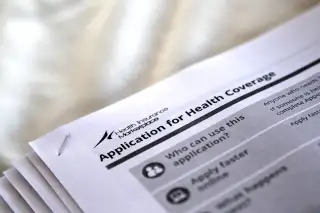If You Had an Obamacare Plan in 2016, Do This One Thing Now

Have you mentally spent your tax refund? If you had Obamacare in 2016, you might want to hold off before accounting for every penny.
That’s because, if you don’t act soon, you could see that refund reduced. Last year, some 60% of Obamacare consumers who received advance premium subsidies and filed their taxes with H&R Block were forced to repay an average $716 of their subsidy, according to the firm. (Many of them didn’t actually cut a check to the government; rather, their average refund was reduced by 38%.)
The reason: These consumers wound up making more in 2015 than they had estimated when they signed up for health coverage through the Obamacare marketplace.
If you expect to be in a similar position when filing your 2016 taxes, you still have a chance to lower your income retroactively: You have until the tax-filing deadline of April 18 to make contributions to both your individual retirement account (IRA) and, if available, your health savings account for 2016. (Only those with a qualifying high-deductible health plan are eligible to make HSA contributions.)
If those contributions bring your income for 2016 more in line with your projections, they can reduce—or even eliminate—any premium subsidy that you’d otherwise owe back. And in the process, they can boost your savings for retirement and medical expenses.
Not sure whether you got a subsidy or not? Subsidy eligibility is based on your modified adjusted gross income (your adjusted gross income plus any of these that apply: untaxed foreign income, non-taxable Social Security benefits, and tax-exempt interest). The upper limits for subsidy eligibility for 2016 are $47,520 for a single person, $64,080 for a family of two, $80,640 for a family of three and $97,200 for a family of four (although higher limits apply in Alaska and Hawaii).
If your household income was under these caps, you likely received a subsidy—even if you never touched the money directly. The government would have paid the subsidy—formally called an "advance premium tax credit"—to your insurance carrier on your behalf, and it was used to lower your monthly insurance premium.
If You Made Too Much ...
The easiest way to lower your liability if you made more than expected is to make an IRA or HSA contribution equal to the amount by which your income exceeded your estimates, says Lindsey Buchholz, tax lawyer at H&R Block. So for example, if you made $1,500 more than you thought you would, make a $1,500 contribution to your IRA or HSA. (If you forgot your 2016 income estimate and obtained coverage through healthcare.gov, log into your account—the marketplace has your application saved.)
To do a precise calculation of how much you would need to contribute to reduce the amount of subsidy you owe back, use IRS Form 8962.
But that assumes your estimates were just a bit off. You could be out of luck if your income blew way past your estimates, particularly if it topped the subsidy threshold for your household size.
If that's the case, check to see if you can make big enough IRA and HSA contributions to get you back to your estimated number (and below the subsidy line). You'll need to consider not only your cash on hand but also the existing contribution limits: The IRA contribution limit for 2016 is $5,500 for individuals under 50 and $6,500 for those 50 and over. The HSA contribution limit for 2016 is $3,350 for self-only coverage and $6,750 for family coverage (this total includes any contributions from an employer, if applicable) for those 54 and under; those 55 and older are allowed an additional $1,000 in catch-up contributions.
If you still end up with a household income that's above the subsidy threshold, you must repay the entire subsidy you received, because you're no longer eligible. If your income fell under the threshold—but you still made more than you expected—you will have to repay a portion of the excess.
If this all seems like a lot of hassle, you can change your game plan for this year. Contact the marketplace where you bought your 2017 health coverage and opt to take less than the full premium subsidy that you’re allowed based on your estimated income, says Laurel Lucia, health care program manager at the UC Berkeley Center for Labor Research and Education. You’ll pay more in premiums now, but you’ll get it back next tax season if your income matches your estimates.